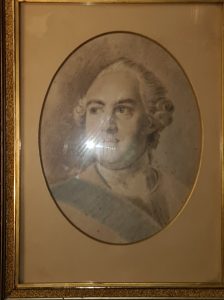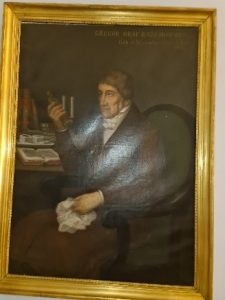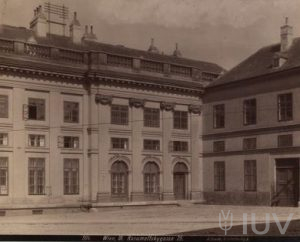Kyrylo Rozumovsky (1728, Lemeshi, Kyiv regiment, Zaporizhian Host, present-day Chernihiv Oblast, Ukraine – 1803, Baturyn, Chernihiv Governorate, Russian Empire) — representative of the cossack Rozumovsky family. Ukrainian military commander, politician and statesman, Hetman, Duke, Count and Field Marshal of the Russian Empire.
Did you know that the descendants of the last Hetman of Ukraine live in Vienna? After reading this small historical account, you will easily recognize the Rozumovsky Palace while strolling through sunny Vienna.
But before that, it is important to revisit the life of Kyrylo Rozumovsky.
Kyrylo Rozumovsky was born in the village of Lemeshi (now Chernihiv region) in March 1728 to Cossack Hryhorii Rozum and Nataliia Rozumyha. Already at the age of 18, after returning from studying in Europe, he became president of the Russian Academy of Sciences. Three years later, after the restoration of the Hetmanate in Ukraine by the Empress Elizabeth I, Kyrylo Rozumovsky was elected Hetman of the Left Bank of Ukraine at the Cossack council in Hlukhiv in 1750.

Kyrylo Rozumovsky, photograph from the family archive of Hrehor Rozumovsky
Despite his young age (at the time of his election as Hetman, Kyrylo was 22 years old), Rozumovsky did plenty to develop the Hetmanate. As history tells us, during the 14 years of Kyrylo’s reign (from 1750 to 1764), the independent Hetmanate reached the level of development of Western European states. Ukrainians are very proud of this, even though not all of the Hetman’s plans were realized. Among the most important reforms and achievements of Kyrylo Rozumovsky were the following:
- A military reform similar to that in Prussia, where regiments were reorganized into regular units and foreign-style military training (mushtra) was adopted. Uniforms and a mandatory set of weapons were also introduced.
- A legal reform that deprived the senior officers of many privileges and raised the Hetmanate to the Western European standard.
- Judicial reform – with a supreme court, the General Military Court, consisting of two judges instead of the Russian monarch. Lower courts were also granted the right of appeal.
- Economy. Taxes on the population of left-bank Ukraine, as well as customs between Ukraine and Russia, were canceled, which made life easier for merchants.
- Education. A project was designed for a European-style university in Baturyn, but Catherine II forbade its establishment. Schools were opened in the Cossack regiments, and the hetman was constantly engaged in the education of Ukrainians.
- Music. Rozumovsky’s court in Hlukhiv was the center of musical life. Prominent Ukrainian composers Artem Vedel, Maksym Berezovsky, and Dmytro Bortniansky studied at the Hlukhiv school.
- Politics. The Hetman regularly organized councils of officers. Such meetings can be considered a prototype of the parliament, and the hetman’s power was to be hereditary.
However, the Russian Empire did not like such important reforms for Ukraine and its citizens. After the death of Elizabeth I, Catherine II abolished the Hetmanate in 1764, and Kyrylo Rozumovsky was not allowed to return to Ukraine for 11 years. When Kyrylo was finally able to do so, he settled permanently in Baturyn, where he was involved in philanthropy and the construction of a palace.
Kyrylo’s sons in Vienna
You may have guessed that Kyrylo Rozumovsky himself never even visited Vienna during his lifetime. (But Mr. Gregor, a descendant of Kyrylo, has a theory that the moment when Kyrylo’s portrait was handed over to his son Gregor may have taken place during their meeting in Vienna.) However, it is an indisputable historical fact that Kyrylo’s descendants have shaped and continue to shape history in the city of Vienna. We are talking about Kyrylo’s sons, Andrii and Hryhorii.
It is known that Andrii, a diplomat and ambassador of the Russian Empire, and Hryhorii, a naturalist by profession, had opposing political views on the Russian Empire, but maintained warm brotherly relations.
Related houses
Andrii Rozumovsky was born in Hlukhiv in 1752. After receiving a high-quality education, first at a special academy and then at the University of Strasbourg, Andrii, like his father, was immediately honored by Catherine II. Therefore, he was soon appointed ambassador of the Russian Empire in Naples. However, Andrii was very fond of Vienna. It was here that he married Elizabeth Thun in 1788. He continued to work as a diplomat for another 19 years.

Portrait of Andrii Rozumovsky, 1776
Hryhorii Rozumovsky was born in 1759. He did not become a politician because he did not agree with the Empress’s views on ruling the empire, and instead took up his favorite activity – geology and mineralogy. Hryhorii traveled a lot and lived for some time near Vienna, in Baden bei Wien, where you can still see his collection of paleontological collections in the Rollettmuseum Baden.

Hryhorii Rozumovsky, photograph from the family archive of Gregor Rozumovsky
Andrii Rozumovsky and Beethoven - a strong friendship and Rozumovsky's quartet
Andrii Kyrylovych built not only a career as a diplomat, but also was fond of music, literally in love with quartet performances. Since musical evenings were a frequent occurrence in Vienna, Andrii Rozumovsky became acquainted with Ludwig van Beethoven. This grew into patronage and a strong friendship. Many people today say that it was Andrii who encouraged Beethoven to write pieces for quartets, because for a long time the composer did not engage with the genre of string quartets at all. Interestingly, the Quartets Op. 59, which Beethoven wrote in Vienna and dedicated to Rozumovsky, featured Ukrainian folk melodies! This confirmed the warm and friendly relationship between Andrii and Ludwig.
In 1808, Andrii Kyrylovych organized the best quartet of the time and the first permanent ensemble in Europe, where he himself was a performer, as the second violin. Beethoven often visited Andrii, because the repertoire of the Rozumovsky Quartet included everything that Beethoven himself had composed, and the quartet performed exactly as the composer wanted. Some researchers say that because of this close friendship, in 1808 Beethoven dedicated his 5th and 6th symphonies to both his friends, Andrii Rozumovsky and Joseph Franz von Lobkowitz. It was Vienna that contributed to the fact that the son of the last Hetman of Ukraine was at the center of cultural life and was well known among the richest and most famous Austrian families of the Habsburg monarchy.
Gregor, a descendant of the Rozumovsky family, talks more about the family in the 5th episode of the project “Happy Birthday, Ludwig!”, which was filmed in Vienna in 2020 in honor of the composer’s 250th birthday.
Congress of Vienna in 1815
As we know, Vienna is famous not only for its cultural life, but also as a center of diplomacy. After the Napoleonic Wars, the Congress of Vienna in 1815 is symbolically considered the beginning of modern history and diplomacy. Andrii Kyrylovych became one of the most important figures at the Congress, where negotiations on the “post-Napoleonic partition of Europe” took place. When looking at the painting depicting the Congress of Vienna, pay attention to the figure of Andrii.

Congress of Vienna, 1815
Another interesting fact is that it was the Vienna Congress that helped to popularize and consolidate the name of the dance we all know today – the Viennese Waltz. You can learn more about this in the article “A Brief History of the Viennese Waltz” in the magazine dedicated to the 5th anniversary of the Ukrainian Ball in Vienna.
Palais Rasumofsky
While walking around Vienna, be sure to visit Palais Rasumofsky, which can be found in the third district on Rasumofskygasse. In the photo, you can see how the palace looked like during the Congress of Vienna, when Andrii Rozumovsky lived there. Here he was setting up his famous art gallery. Read more about this in the section on buildings, in particular the Palais Rasumofsky.
Interesting Facts
Hetman Kyrylo Rozumovsky did not speak Russian, but only Ukrainian. During diplomatic communication, French prevailed. He was also fluent in German.
In the Quartets Op. 59, which Beethoven wrote in Vienna and dedicated to Andrii Rozumovsky, featured Ukrainian folk melodies!
The son of the last hetman, Kyril Rozumovsky, Andrii, was one of the most important figures at the Congress of Vienna in 1815.
References:
- Український інститут національної памяті «1728 – народився Кирило Розумовський, останній гетьман Лівобережної України».
- Елена Минина, «Gregor K. RASUMOFSY – Wissenschaftler und Forscher».
- Тиждень «Кирило Розумовський та українське Просвітництво».
- Проект «Happy Birthday Ludwig!».
- Скарби нації. Україна. Повернення своєї історії – Фільм третій 1+1.
- Інтерв’ю графа Грегора Розумовського для Ukrainian Time.
- Інтерв’ю графа Грегора Розумовського Ukrinform.
- Club for European Understanding and Communication – Vienna.
- Reality Bites Initiative in Vienna.
- Masson, Mémoires secrets sur la Russie. Paris. Firmin Düot. 1762-1807.


